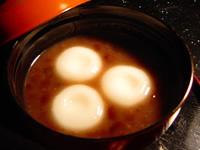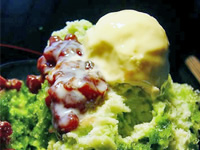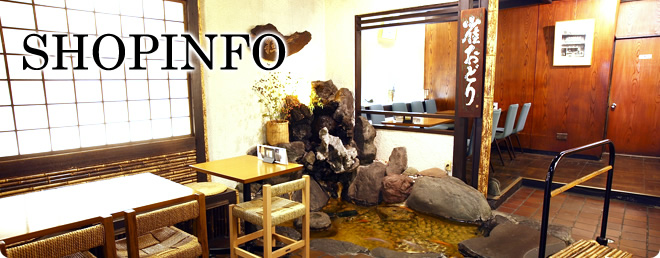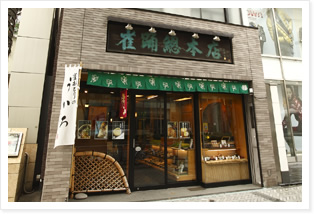 Suzume Odori is a Japanese confectionary shop located in Nagoya’s Sakae district.
Suzume Odori is a Japanese confectionary shop located in Nagoya’s Sakae district.
It was started in 1856 during the Edo period and is currently run by its seventh-generation owner.
Please enjoy the taste of our traditional Japanese confectionaries such as uiro with its deliciously subtle sweetness made from rice, anmitsu, zenzai, or tokoroten.

Shop Name: Suzume Odori Flagship Store
Holidays: None (except for New Year’s Day)
Hours: 10:30 am to 7:00 pm (tea house closes at 6:30 pm)
Telephone: 052-241-1192
FAX: 052-241-1058
e-mail: info@suzumeodori.com
Address: 3-27-15 Sakae, Naka-ku, Nagoya-shi
* Sakae Otsu Dori in front of Matsuzakaya South Wing next to GAP
Access:
10 minutes – Sakae Station on the Higashiyama Line from JR Nagoya Station
5 minutes – Yabacho Station on the Meijo Line
20 minutes – Tomei Expressway Nagoya IC towards West Hirokoji Dori

- Uiro:
This is Nagoya’s traditional Japanese confection. Made from rice flour and painstakingly selected ingredients, the uiro are made daily by hand using a method that steams the uiro for a long period with a large amount of steam after being gently kneaded by craftsmen. Please give its rustic flavor and chewiness a try.

- Anmitsu:
This treat is cubes of agar jelly eaten with a topping of adzuki beans, soft rice cake, seasonal fruit, or other topping and covered with syrup (black or white). Suzume Odori’s anmitsu changes with the seasons. Spring brings a strawberry topping, summer apricot, and winter and fall see chestnut.

- Zenzai:
It features three white sweet rice flour dumplings in a red bean paste made from adzuki beans boiled with sugar. It is a sweet that warms the body and cools off as you eat it. It’s also available with mochi rice cakes or chestnuts.

- Tokoroten:
This is a food made by boiling seaweed and then cooling the agar it produces. It is then cut into noodle-like strands using a special device known as a tentsuki. For flavoring you can choose from slightly sour soy sauce or Nagoya’s famous red miso. It’s also famous as a diet food in Japan.

- Powdered Green Tea and a Seasonal Japanese Sweet:
You can enjoy the taste and appearance of seasonal Japanese. Comparatively few kinds of ingredients like sugar, mizuame syrup, rice, wheat, and adzuki beans play out the four seasons of Japan in an infinite number of variations. Please sample the taste of rich Japanese powdered green tea (matcha) with these Japanese sweets on the side.

- Kakigori:
This is a frozen treat made from shaved ice covered with syrup. Kakigori will cool off your hot, sun-bathed body in a flash, and it’s a summer tradition in Japan. You can choose the topping of your liking, including ice cream, fruit, or red bean paste.
Suzume Odori is a town Japanese confectionary store operating in Nagoya’s Sakae. It has been in operation since long ago in the Edo period and is currently run by a seventh-generation owner.
What kind of town was Nagoya, then called Owari Province, during the Edo period? Nagoya was a city of culture and commerce centered on Nagoya castle as the castle town of the domain of the Owari line of the Tokugawa clan. It was a stopping point on the Tokaido road which linked Edo and Kyoto, and it had fertile Nobi Plain unfolding from Gifu, the mountains of Nagano, and the Kiso River. Before your eyes was the sea route leading to Ise Jingu. Its central area was a center of trade and culture due to its advantageous location. Long ago it was a town that achieved independent development and was an affluent place with a rich local character.
A gentle and kind personality with a local flare, staying close to your roots, and working an honest job, these are the characteristic of a true Nagoyan. Nagoya has been a town with easy living and a relatively high level of culture from before the Edo period to the present day.
-

This is our home in the 1950s. It hasn’t changed a bit, but its surroundings sure have. The story goes that the sign on the roof blew away during a typhoon sometime in the late 50s or early 60s.
-

This is the Nagoya Sakae TV tower. It was a TV tower in the 1950s when television was beginning to spread in Japan.
-

This is a family portrait from the 1950s. The matching hairstyles and happi coats look good, don’t they? Ha ha ha. Incidentally the center of the portrait is occupied by our grandmother from the fourth generation of owners. The people in the photograph are all now in their 60s.
-

This is the current Suzume Odori Flagship Store.








